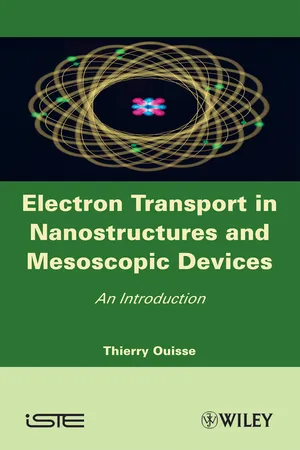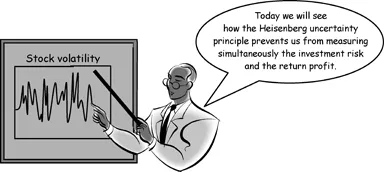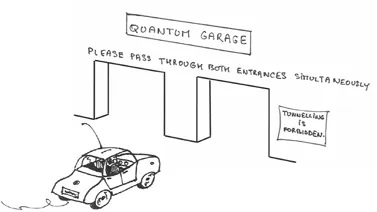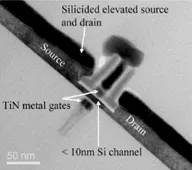![]()
Chapter 1
Introduction
1.1. Introduction and preliminary warning
Matter stability and the way in which rigid crystalline or amorphous arrays of atoms can be formed are ruled y two pillars of physics: electromagnetism and quantum mechanics; nothing else, provided that we admit the existence of elementary constituents such as atom nuclei without having to derive their internal structure from the first principles (then we need to add nuclear forces to our bunch of tools). The postulates and basic equations of these two theories can be written on a couple of pages, and everything can be derived from them1. If the world was ruled by classical mechanics, it would simply be impossible to obtain stable atoms2 or stable chemical bonding to ensure the existence of matter as we all experience it in our everyday life. Thus, it is something of a misnomer to say that we are going to study quantum devices as opposed to devices which would not be quantum. Everything is ruled by quantum mechanics, from the insulating or conducting character to the color of any piece of matter or object that you can see inside the room where you are now reading this introduction (see also Figure 1.1). To understand our macroscopic world, we often feel that once we admit the existence of stable matter, we can content ourselves with using the second Newton’s law of motion and classical gravitational forces. An aeronautics engineer does not put too much quantum mechanics in his calculations, but this is certainly no longer the case if we want to justify the way in which electrons and therefore the electrical current behaves in a bulk semiconductor. Without a periodic atomic lattice and quantum mechanics, we could not find free electrons able to carry a current in a p-n junction, or in the channel of transistors which form the integrated circuits inside our computers. Thus, the reason why the devices under study in this book are called quantum is that we can straightforwardly apply to them the basic quantum effects that students are accustomed to calculating in an introductory quantum mechanics course.
In nanostructures, electrons can be confined in potential wells narrow enough to obtain energy quantization along the confining direction. Their dimension is small enough for probing the dual wave-particle nature of the electron in a straightforward manner, because the electron wave function phase can be kept coherent over the whole device length. Thus, it becomes possible to observe wave interference effects just by measuring the average current which can be passed through such components, and particle-like properties from current noise data. As once stated by the physicist Esaki, this looks like some kind of “do-it-yourself” quantum mechanics: you are not required to become a specialist in group theory and irreducible representations, or of field-theoretic methods to get in touch with the essence of the topic (see also Figure 1.2). In addition, other specific effects, although not quantum-mechanical, are also due to reduced dimensions: if you can inject a few electrons into a nanostructure and if the capacitance between this nanostructure and the rest of the world is very small, we can probe effects which are due to charge granularity (we cannot divide the electron charge), and which are known as Coulomb blockade. Such effects are the subject of intensive research in R&D laboratories, because many people hope to put them to good use to produce new types of memories and devices that are smaller, faster and require a smaller amount of operating power. The aim of this book is to give an introduction to the basic concepts which govern the conduction mechanisms taking place in such small devices.
Many (not to say most) of the phenomena described in this book usually take place at quite low temperatures, or in devices not yet (and for some of them never) used in the industry. The physics described here is not useful for understanding how industrial semiconductor devices behave in most applications right now, with the notable exception of resonant tunneling. Nevertheless, “today’s” silicon (Si) Metal-Oxide-Semiconductor Field-Effect Transistors (MOSFETs) definitely exhibit non-stationary and ballistic transport effects. Explaining these effects requires us to use some of the concepts developed in this book, even the high electric fields involved in MOSFET operation make the application of such concepts much more complicated than what is described in this introduction. At room temperature, the electron mean free path in silicon is in the 5-10 nm range, not far from the 45 nm channel length of the current CMOS technology, and integrated chips using a 32 nm process technology have already been demonstrated by the INTEL corporation in 2007. Figure 1.3 shows the picture of a 20 nm channel length prototype MOSFET produced in 2006 by LETI-CEA. Thus, even at room temperature some commercial electronic devices are close to the ballistic regime. Those industrial MOSFET’s are fabricated with an incredibly high reproducibility in order to form extremely complex integrated circuits (and as a side note such precision and reproducibility are actually far from being achieved in most research laboratories working in the realm of mesoscopic physics and nanostructures, or with semiconductors more exotic and physically more appealing than silicon). Device-modeling based on ballistic properties has thus become an active research field, even in the case of silicon devices (see, e.g., [NAT 94] for one of the pioneering Si papers).
In addition, mesoscopic effects are important in four respects:
(i) they are often of great physical significance, and give a deep and straightforward insight into some of the most striking implications of quantum mechanics (for instance, they provide unambiguous and clear demonstrations of the dual electron nature, particle and wave);
(ii) although often obtained at low temperatures or high magnetic fields they are very useful for extracting physical parameters dealing with (nano)structures actually used in applications;
(iii) some of the effects are already used in (e.g. resonant tunneling) or potentially useful for (e.g. Coulomb blockade) applications;
(iv) although still difficult to engineer, devices made from graphene or carbon nanotubes exhibit truly ballistic and quantum-coherent effects even at room temperature. Thus, it is quite possible that not only ballistic, but also quantum-coherent effects may be present in electronic applications in the near future.
As a consequence, in most of the largest semiconductor companies, and in a very large number of university labs, intensive research work is devoted to such structures. Scarcely applied though it may seem at first sight, this field of activity is in fact the leading edge of semiconductor research.
This book is designed to be accessible to the independent reader, and to students not having a strong background in solid-state physics (e.g. issued from engineering disciplines). As a matter of fact, this book is an attempt to answer the following question: what must be taught to students starting from scratch to make them understand the bases of electron transport in mesoscopic devices? A professor placed in such a situation soon realizes that a good deal of solid-state physics and quantum mechanics is required. This explains the incorporation of chapters which are usually absent from the more specialized, already-existing books, and marks the difference between them and this. In addition, to follow the classification once given by J.M. Ziman, this book does not fall into the category of a “treatise” but into that of a “textbook”, with the purpose of introducing and explaining concepts. The text has been written with the aim of being as self-contained as possible, and is based on an oral course delivered at an international European master’s degree course involving three technical universities (GrenobleINP, EPFLausanne and Polit’oTorino). It is a deliberate choice of the author to keep in the book the spirit of the oral course, and this is the reason why the reader should not be surprised to be sometimes interpellated or hailed in a somewhat familiar way3.
Assimilating the quantum-mechanical rules summarized at the very beginning of the book suffices to derive any subsequent result, but should by no means be considered as enough to master quantum mechanics itself. Hence, and despite the fact that the text remains at an introductory level, a complete understanding of the course probably requires a minimum prior knowledge and self-maturation of the basic quantum-mechanical concepts. A reader not acquainted with this field will certainly feel the need to consult more authoritative manuals, due to the innumerable number of questions, either technical or fundamental, that a concise and incomplete presentation of quantum mechanics must arouse in any normally constituted mind. Some knowledge of solid-state and semiconductor physics certainly help as well, but all concepts useful for understanding the book can in principle be found in the book itself, and since this book is an introduction dedicated to a broad audience, maybe some of you are probably already acquainted with the required solid-state physics notions. For those who are experienced in solid-state physics it is possible to simply skip most of the reminders which make up Chapter 2. Besides, many of those reminders are not always quite rigorously demonstrated. All undemonstrated or heuristically-derived quantum-mechanical formulae can be found and are rigorously derived in a self-contained, encyclopedic textbook: [COH 77]. Solid-state physics has its self-contained book too: [ASH 76]. For bulk semiconductor physics and transport, an advanced and quite remarkable and complete textbook was written by [RID 82], but it is not essential for understanding this book. Eventually, we can find books specifically devoted to mesoscopic electron transport, which can be of great support for a better understanding or for gaining more information (the list below is not exhaustive): [BEE 91], [KEL 95], [DAT 95] and [FER 97]. The book which is the closest in spirit to this course is the one by Datta. It includes many exercises and also contains more advanced formalisms (e.g. Green’s functions) and discussions,which are not necessarily required at this introductory level. The book by Kelly presents a very large amount of data and also deals with aspects which are either more related ...



